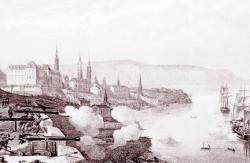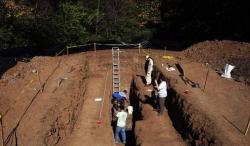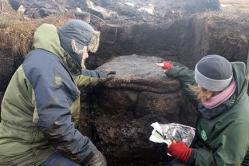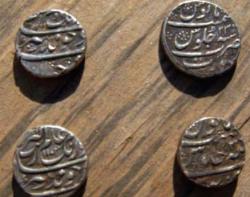29 DECEMBRE
INDI-UNI : ANTHROPOLOGY - ARCHAEOLOGY
INSCRIPTION 2012 COURS A DISTANCE
REGISTRATION 2012 ONLINE COURSES
CANADA –  Québec - Les épaves potentielles retrouvées dans le fond du fleuve Saint-Laurent en face de Québec pourraient appartenir à des voiliers français datant de l'époque du fondateur de la ville, Samuel de Champlain, ou même à des vaisseaux anglais coulés lors de la fameuse bataille de Québec de 1690. C'est du moins les hypothèses retenues par l'historien militaire et ex-recteur du Collège militaire de Saint-Jean, Jacques Castonguay, au sujet des 15 «entités non identifiées» récemment découvertes dans le cours d'eau à la hauteur de la ville par le Service hydrographique du Canada (SHC). Les épaves potentielles, qui mesurent de 8,5 à 41 mètres de long, pourraient ainsi témoigner de la construction navale à l'époque de la Nouvelle-France après l'arrivée de Samuel de Champlain en 1608. «Les voiliers représentaient le seul moyen de locomotion entre Québec et Saint-Malo», rappelle l'historien. Et puisque ceux-ci traversaient l'océan Atlantique et qu'ils n'étaient pas aussi robustes que les bateaux d'aujourd'hui, nombre d'entre eux devaient être réparés ou tout simplement démolis après être arrivés à bon port.
Québec - Les épaves potentielles retrouvées dans le fond du fleuve Saint-Laurent en face de Québec pourraient appartenir à des voiliers français datant de l'époque du fondateur de la ville, Samuel de Champlain, ou même à des vaisseaux anglais coulés lors de la fameuse bataille de Québec de 1690. C'est du moins les hypothèses retenues par l'historien militaire et ex-recteur du Collège militaire de Saint-Jean, Jacques Castonguay, au sujet des 15 «entités non identifiées» récemment découvertes dans le cours d'eau à la hauteur de la ville par le Service hydrographique du Canada (SHC). Les épaves potentielles, qui mesurent de 8,5 à 41 mètres de long, pourraient ainsi témoigner de la construction navale à l'époque de la Nouvelle-France après l'arrivée de Samuel de Champlain en 1608. «Les voiliers représentaient le seul moyen de locomotion entre Québec et Saint-Malo», rappelle l'historien. Et puisque ceux-ci traversaient l'océan Atlantique et qu'ils n'étaient pas aussi robustes que les bateaux d'aujourd'hui, nombre d'entre eux devaient être réparés ou tout simplement démolis après être arrivés à bon port.
http://www.cyberpresse.ca/le-soleil/actualites/la-capitale/201112/26/01-4481059-les-epaves-decouvertes-dans-le-fleuve-devant-quebec-pourraient-dater-de-400-ans.php?utm_categorieinterne=trafficdrivers&utm_contenuinterne=cyberpresse_vous_suggere_4480903_article_POS1
USA –  Cool Springs - A Cool Springs archaeological dig keeps yielding details about Paleolithic man and the big game he hunted. State archaeologists say discoveries unearthed in 2010 at a long-studied archaeological site known as Coats-Hines in Cool Springs reveal it to be one of only a few sites that show early man in this area hunted and ate “megafauna,” a term describing very large animals.Scientists confirm finding three and possibly four mastodons — large elephant-like creatures with tusks — at the site, with one mastodon, known as Mastodon B, having “unequivocal association” with human activity in the form of butchering marks. An archaeological excavation turned up the bones, artifacts and animal remains that archaeologists now say prove human activity occurred here before 12,000 B.C. The site is in the backyard of a private home and is one of the two oldest human settlements documented in Tennessee. Archaeologists and Middle Tennessee State University students turned up human artifacts, pollen samples and more than 1,500 animal bones that can be traced to a variety of species. Excavations at the property in 1994 revealed the only known example in the Southeastern U.S. of mastodon remains directly associated with human-made stone tools in an undisturbed context, said Deter-Wolf, state prehistoric archaeologist.
Cool Springs - A Cool Springs archaeological dig keeps yielding details about Paleolithic man and the big game he hunted. State archaeologists say discoveries unearthed in 2010 at a long-studied archaeological site known as Coats-Hines in Cool Springs reveal it to be one of only a few sites that show early man in this area hunted and ate “megafauna,” a term describing very large animals.Scientists confirm finding three and possibly four mastodons — large elephant-like creatures with tusks — at the site, with one mastodon, known as Mastodon B, having “unequivocal association” with human activity in the form of butchering marks. An archaeological excavation turned up the bones, artifacts and animal remains that archaeologists now say prove human activity occurred here before 12,000 B.C. The site is in the backyard of a private home and is one of the two oldest human settlements documented in Tennessee. Archaeologists and Middle Tennessee State University students turned up human artifacts, pollen samples and more than 1,500 animal bones that can be traced to a variety of species. Excavations at the property in 1994 revealed the only known example in the Southeastern U.S. of mastodon remains directly associated with human-made stone tools in an undisturbed context, said Deter-Wolf, state prehistoric archaeologist.
http://www.tennessean.com/article/20111227/WILLIAMSON/312270032/Franklin-dig-evidence-reveals-mastodon-butchered-by-ancient-humans
ROYAUME UNI –  Whitehorse hill - A monument on Dartmoor has been restored to its previous condition after a stone that had been removed for laboratory analysis was returned. Beads, worked leather and cremated human remains have been discovered in a cist, or burial chamber/chest, at Whitehorse hill after it was removed by Dartmoor National Park Authority's archaeology and conservation works teams. There are roughly 200 cists on Dartmoor, all hidden in the ground or inserted into barrows. The Whitehorse hill cist is unique as it is the only known example set within a peat mound. It was first discovered 10 years ago when one of the side stones fell out of the peat mound. Over time, the peat has slowly eroded away revealing more of the cist and its contents. After several failed attempts to protect it as a scheduled monument, Dartmoor National Park Authority and English Heritage decided to excavate it in order to recover any surviving archaeological and environmental information before it was lost. One of the stones that was excavated from Dartmoor has now been safely returned with the help of a MoD all-terrain vehicle.
Whitehorse hill - A monument on Dartmoor has been restored to its previous condition after a stone that had been removed for laboratory analysis was returned. Beads, worked leather and cremated human remains have been discovered in a cist, or burial chamber/chest, at Whitehorse hill after it was removed by Dartmoor National Park Authority's archaeology and conservation works teams. There are roughly 200 cists on Dartmoor, all hidden in the ground or inserted into barrows. The Whitehorse hill cist is unique as it is the only known example set within a peat mound. It was first discovered 10 years ago when one of the side stones fell out of the peat mound. Over time, the peat has slowly eroded away revealing more of the cist and its contents. After several failed attempts to protect it as a scheduled monument, Dartmoor National Park Authority and English Heritage decided to excavate it in order to recover any surviving archaeological and environmental information before it was lost. One of the stones that was excavated from Dartmoor has now been safely returned with the help of a MoD all-terrain vehicle.
http://www.thisisdevon.co.uk/Whitehorse-monument-reveals-ancient-secrets/story-14251782-detail/story.html
PAKISTAN –  Devri Jo Daro - For years the people of the Bagrani community have cared for a 200-year-old historical site known to them as, Devri Jo Daro (mound of the top), around 17 kilometres away from taluka Matli in Badin district. The mound is spread on 26 acres and is surrounded by the Devri village which got its name from the mound it engulfs. “Devri” is a Hindi word which means “top.” Legend has it that it could refer to the tall stupas – towers that were built with inscriptions of the Buddha when Buddhist kings ruled the subcontinent. Although the land revenue records name the place Junaj jo Daro and declare it to be inhabited by a Hindu community, Devri jo Daro is the more popular name. According to the Bagranis the mound faces the threat of destruction. Another community, albeit a powerful one too – the Nizamanis, moved to the area after the floods. They have set up pickets on the mound and are destroying the artefacts, they say. The people of Devri [Bagranis] resorted to protesting outside the office of the deputy commissioner of Badin district around ten days ago after their repeated complaints went unheard by the area SHO. The other sites Bhambro referred to are also present in Badin. They are Malyan Jo Daro, Kokal Jo Daro, Markhyan Jo Daro and Githo Jo Daro. They too, still await any step to preserve them.
Devri Jo Daro - For years the people of the Bagrani community have cared for a 200-year-old historical site known to them as, Devri Jo Daro (mound of the top), around 17 kilometres away from taluka Matli in Badin district. The mound is spread on 26 acres and is surrounded by the Devri village which got its name from the mound it engulfs. “Devri” is a Hindi word which means “top.” Legend has it that it could refer to the tall stupas – towers that were built with inscriptions of the Buddha when Buddhist kings ruled the subcontinent. Although the land revenue records name the place Junaj jo Daro and declare it to be inhabited by a Hindu community, Devri jo Daro is the more popular name. According to the Bagranis the mound faces the threat of destruction. Another community, albeit a powerful one too – the Nizamanis, moved to the area after the floods. They have set up pickets on the mound and are destroying the artefacts, they say. The people of Devri [Bagranis] resorted to protesting outside the office of the deputy commissioner of Badin district around ten days ago after their repeated complaints went unheard by the area SHO. The other sites Bhambro referred to are also present in Badin. They are Malyan Jo Daro, Kokal Jo Daro, Markhyan Jo Daro and Githo Jo Daro. They too, still await any step to preserve them.
http://tribune.com.pk/story/312871/historical-site-cared-for-by-one-community-could-be-destroyed-by-another/
USA - Stallings Island - American Indians first created pottery in what would, thousands of years later, become Columbia County. Anthropologist Rowe Bowen presented many such facts about Stallings Island during a recent presentation. The cooking pottery, created in the late Archaic period about 4,000 years ago, was formed with clay and vegetable fibers, Bowen said. Stallings Island, located in the middle of the Savannah River just below the Steven Creeks Dam, is protected by the Archaeological Conservancy. The presentation mainly focused on the Paleo and Archaic peoples and the “cultural ecology” of the island. “(Cultural ecology) is the meshing of people and their culture with the environment,” Bowen said. The Paleo American Indians, or “old Indians,” were believed to have travelled from Asia across the Bering Strait when a glacier connected the continents, Bowen said. As the weather warmed, the resources changed, and the Paleo hunters became Archaic hunter-gatherers. The new animals caused the weapons to change as well, Bowen explained. The newly invented atlatl allowed the natives to throw farther, quicker and more accurately than with spears. Because resources remained consistent, the natives stayed in one area long enough to build houses. This led to the invention of the chip-stone axe, Bowen said. In addition to discussing the invention of pottery, Bowen told pupils about how the Stallings Island area’s abundance of resources affected the residents. The island is near the junction of the Piedmont, coastal plain and fault line areas, which expanded the number and variety of resources available to the area’s early residents, Bowen said.
http://newstimes.augusta.com/news/2011-12-28/archeologist-teaches-students-about-stallings-island
AUSTRALIE – Bunbury - Shipwreck graveyard found beneath WA carpark. A hidden treasure has been unearthed five metres below the surface of a council car park in a coastal WA town.
INDE – Hyderabad - The Qutb Shahi kings can rest in peace. Their final abode is in for restoration at last. The Agha Khan Trust for Culture (AKTC) has come forward to take up conservation and landscape restoration of the Qutb Shahi Tombs complex. A formal MoU is expected to be signed between the AKTC and the State Department of Archaeology. After successful restoration of the Humayun's Tomb in Delhi, this will be the second heritage site to be developed by AKTC in India. The Historic Cities Programme of AKTC aims at conservation of best of Islamic architecture and traditions across the world. Not just the cluster of seven Qutb Shahi tombs, but all the 150 graceful structures in the 130 acre royal necropolis will be restored in a way that can spur social, economic and cultural development. The grand mausoleums, including that of City founder, Mohd Quli Qutb Shah, are known for elaborate and intricate architecture.
http://www.thehindu.com/news/cities/Hyderabad/article2752854.ece